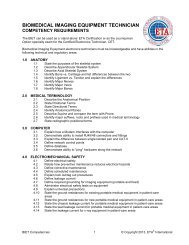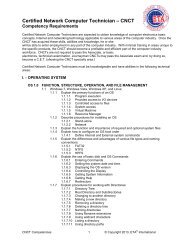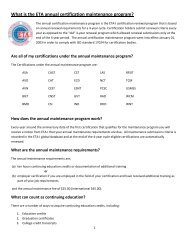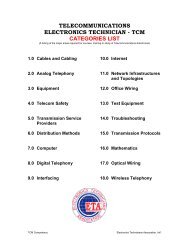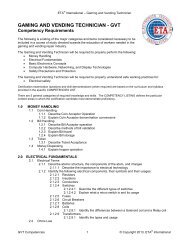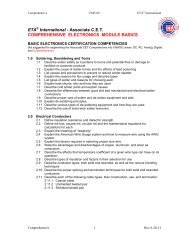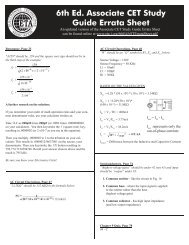Create successful ePaper yourself
Turn your PDF publications into a flip-book with our unique Google optimized e-Paper software.
-V curves for a typical solar module are illustrated in Fig. 3. Remember: a constant-currente maintains a constant current, independent of the voltage across it. The horizontal curvese constant-current regions of operation. The maximum power point is at the knee of the I-The I-V curves for a typical solar module are illustrated in Fig. 3. Remember: a constant-currentsource maintains a constant current, independent of the voltage across it. The horizontal curvesare the constant-current regions of operation. The maximum power point is at the knee of the I-V curve. This is the point at which the solar module is delivering the maximum electrical energyve. This The is the I-V point curves at which to its load.for a typical the solar solar module is delivering the maximum electrical energyload. module are illustrated in Fig. 3.Remember: a constant-currentsource maintains a constantcurrent, independent of thevoltage across it. The horizontalcurves are the constant-currentregions of operation. The maximumpower point is at the kneeof the I-V curve. This is thepoint at which the solar moduleFigure 3.is delivering the maximum electricalenergy to The its load. Solar ArrayThe solar array drives an inverter (which is a DC-to-AC converter). Inverters have specified DCinput voltage requirements. They also need certain levels of DC input power to provide thedesired AC output power. Solar modules are connected in series to increase the voltage to meetthe inverter needs. The series strings are connected in parallel to increase the available current,which establishes the DC input power to the inverter. Consider Fig. 4. In this 2 X 6 array wehave 12 (Sanyo 205N) solar modules arranged to provide 244 V at a current of 10 A. ThisThe Solar ArrayFigure 3.The solar array drives an inverter (which is a DC-to-AC converter).Inverters have specified DC input voltage requirements.They also need certain levels of DC input power toSolar Array results in 2440 watts of DC input power for our DC-to-AC inverter.provide the desired AC output power. Solar modules are connectedin series to increase the voltage to meet the inverterneeds. The series strings are connected in parallel to increased.the available current, which establishes the DC input power tothe inverter. Consider Fig. 4. In this 2 X 6 array we have 12(Sanyo 205N) solar modules arranged to provide 244 V at acurrent of 10 A. This results in 2440 watts of DC input powerfor our DC-to-AC inverter.System Problems and LimitationsThe scheme shown in Fig. 5 is a pretty standard arrangementand complies with NEC (National Electric Code) 2008. However,there are several issues of concern.First, each of the array modules should be matched closelyand be subjected to the same irradiance (W/m2). Modules inseries develop a branch (series-string) current can be loweredby a single module that produces a current less than its ratedvalue. Residential and small-business solar installations arefaced with a number of challenges to providing good efficiencywhile maintaining rated output power. An array in the northernhemisphere may not face true south. Conceivably, the availableroof area and the roof design may not permit all of the solarmodules to even face in the same direction (Fig. 6) Shadingof solar panels by neighbors’ trees or utility poles causesadditional panelto-panelvariationin power output.This means not allof the solar moduleswill receivethe same amountof sunlight (irradiance)simultaneously.Figure 6.curves for a typical solar module are illustrated in Fig. 3. Remember: a constant-currentaintains a constant current, independent of the voltage across it. The horizontal curvesolar onstant-current array drives regions an inverter of operation. (which is The a DC-to-AC maximum converter). power point Inverters is at the have knee specified of the I-DC. voltage This is requirements. the point at which They the also solar need module certain is levels delivering of DC the input maximum power electrical to provide energy theed AC output power. Solar modules are connected in series to increase the voltage to meetverter needs. The series strings are connected in parallel to increase the available current,h establishes the DC input power to the inverter. Consider Fig. 4. In this 2 X 6 array we12 (Sanyo 205N) solar modules arranged to provide 244 V at a current of 10 A. Thists in 2440 watts of DC input power for our DC-to-AC inverter.Bypass diodes can divert current around all or part of a shaded module. Refer to Fig. 7.Solar voltage panels across also the collect series string dirt will and be reduced. require Since washing the string at is in regular parallel with otherFigure 4.intervals.stringsFurther,in array,solarthe entirepanelsarray voltage atwillslightlybe reduced.differentEssentially,rates,the entire arrayperformance can be affected by a single module.Lilliputian Inverters Slay Array Problems which cause Page even 3 more variations in panel outputs.Bypass diodes can divert current around all or part of a shadedmodule. Refer to Fig. 7. The Figure voltage 6. across the series stringwill be reduced. Since the string is in parallel with other seriesBypass diodes can divert current around all or part of a shaded module. Refer to Fig. 7. Thestrings in the array, the entire array voltage will be reduced.Figure 3.voltage across the series string will be reduced. Since the string is in parallel with other seriesEssentially, the entire array performance can be affected by astrings in the array, the entire array voltage will be reduced. Essentially, the entire arraysingle module.performance can be affected by a single module.olar Arrayr array drives an inverter (which is a DC-to-AC Figure 4. converter). Inverters have specified DCltage requirements. They also need certain levels of DC input power to provide theAC tian output Inverters power. Slay Array Solar Problems modules are The connected Inverter in series to increase the voltage to meet Page 3rter needs. The The inverter series strings includes are maximum connected in power parallel point to increase tracking the (MPPT) available current,stablishes to the optimize DC input the power array to energy the inverter. transfer. Consider Grid-interactive Fig. 4. In this invertersInverter act solar like modules current arranged sources to and provide synchronize 244 V at their a current ac current of 10 A. This2 X 6 array we(Sanyo 205N) Then 2440 watts The delivery inverter of DC includes to input the maximum power (utility) power for grid point our tracking voltage. DC-to-AC (MPPT) As to inverter. optimize an example the array energy we shalltransfer. Grid-interactive inverters act like current sources and synchronize their ac currentuse a Sunny Boy 2100U inverter. The basic installation wiringbasic is installation provided wiring in is Fig. provided 5. in Fig. The 5. The grid-tied inverter can deliver can a maximum deliver adelivery to the (utility) grid voltage. As an example we shall use a Sunny Boy 2100U inverter.Theof maximum 2100 watts of ac of power.Figure 7.2100 watts of ac power.Lilliputian Inverters Slay Array ProblemsFigure 4. 5.Figure 5.n Inverters Slay Array Problems Page 3System Problems and LimitationsFigure 7.JAN/FEB2010 | etainternational.org | 5



